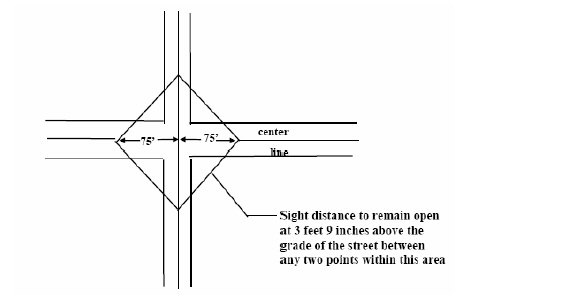The location and height of all fences, walls, and vegetation shall be in accordance with the following provisions:
(a) Fences, Walls, and Vegetation in Front Yards: No fence or wall shall be permitted within any required front yard setback and no hedge shall be permitted within any front yard setback above the height of four (4) feet.
(b) Visibility at intersection: No structure, fill or vegetation shall be erected, placed, planted, or allowed to grow on any corner lot so as to create a sight impediment within seventy-five (75) feet of the intersecting centerlines of any two or more streets. In determining if any sight impediment exists, the Zoning Inspector shall measure the sight distance between the centerlines of such streets at a height of three feet, nine inches (3'9") above the actual grades of the streets. (See Illustration)
 |
(c) Fences, Walls, and Vegetation in Side and Rear Yards: No fence or wall shall be permitted within any side or rear yard which exceeds six (6) feet in height. Dense evergreen plantings, deciduous trees, shrubs, or hedges, or other vegetation may exceed six (6) feet in height within any side or rear yard.
(d) Screening: Fences, walls, or vegetation used for required screening as outlined in Section 1117.15
, may exceed six (6) feet in height upon approval by the Zoning Inspector or Board of Zoning Appeals.
(e) Security Fences: Security Fences for uses within non-residential districts may exceed six (6) feet in height.
(f) Barbed Wire and Electric Fences: Barbed wire and electric fences shall be prohibited within any residential district; barbed wire and electrified sections of fences when used for security purposes within any non-residential district, shall be a minimum of eight (8) feet above the ground.
(g) Fences Prohibited Within Right-of-Way: Fences and walls shall not be permitted within any right-of-way.